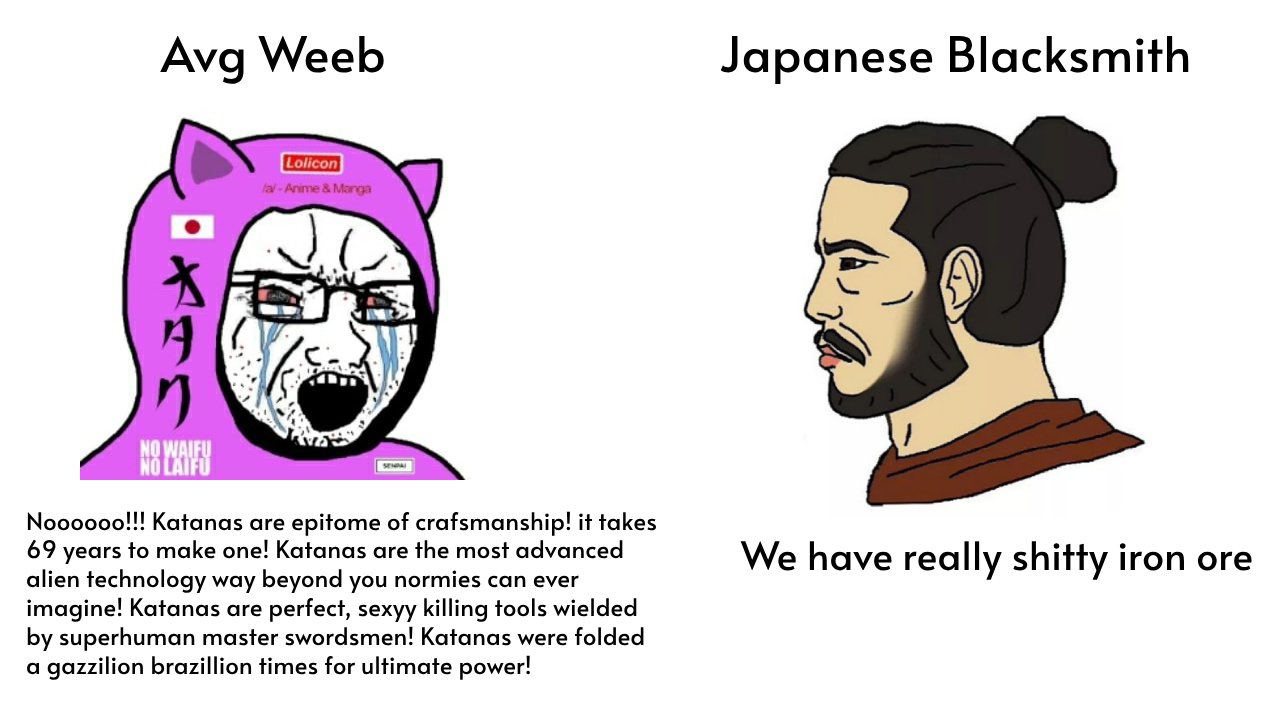113
you are viewing a single comment's thread
view the rest of the comments
view the rest of the comments
this post was submitted on 09 Aug 2023
113 points (93.1% liked)
Anime
9764 readers
1 users here now
Anime is hand-drawn and computer animation originating from Japan.
Anime; the one thing that gets us closer to each other and brings us together.
 All spoilers must be tagged!
All spoilers must be tagged!
founded 5 years ago
MODERATORS

I suppose it could also come down to how you look at the situation at hand. If dexterity and speed of swing are paramount, maybe having a lighter thinner blade would give the advantage. Euro swords definitely have a leg up in raw durability though, that's for certain.
That's the thing, though, European swords cover the whole gamut from ridiculously light foils to nutso zweihanders.
I get that Japanese swords are the same and there are ridiculous nodachi and tiny little wakizashi but the difference is of size more than form.
There's much more variation in European swords so it's hard to say 'the Japanese sword is better than the European one' because there's almost definitely a European sword specialized for whatever use case you're comparing the swords for.
That in and of itself is actually very important; why is there more variation in European swords? Because of armor -- chain mail & shields, specifically. The widespread deployment of these technologies demanded bespoke counter-innovations, such as the estoc (which could pierce chain mail) and the longsword (which could survive hard impacts while still being finessed around shields). These comparatively clumsy arms evolved in direct response to an environment which was overly effective at thwarting the brutal efficiency of the light blade.
True, armor did exist in Japan, though, for most of Japanese history, distribution was largely limited to the Samurai class due to material scarcity. The common footsoldier, instrumental in all war, was generally forced to make do with much less, so simple blades were already extremely effective against them. As a result, there were major innovations in anti-sword arms, such as the naginata and yari, while swords evolved more slowly in response (e.g.: the tachi being replaced by the katana).
Eventually, effective anti-sword armor did become more widespread, but we can only speculate as to what innovation it might have spurred because this era was abruptly cut short through the introduction of the matchlock rifle. Matchlocks were so devastatingly effective against Japanese armor that, by the start of the 17th century, Japan likely had more guns than any other country on Earth. The vast majority of these firearms were manufactured domestically -- as one might imagine, there was no shortage of potential gunsmiths to be recruited from the swordmaking industry. As for gunpowder... where the island was once stingy with iron, saltpeter and sulfur were provided in eager abundance.
I have fought with many kinds of European blades, from longswords to zweihanders to sabres and foils. Some of these can be very light and thin. In fact, the average longsword weighs the same as the average katana: between 1.1 and 1.5 kg. But I'll take the length, cross guard and double edge of a longsword over a katana every day.
Source: I practice HEMA
Yeah the handguards are important as well, same with balancing and leverage.
Also making a sword sharper doesn't make it better, the Zweihänder for example has a relatively blunt edge on purpose so you can handle it better in close combat by grabbing the blade.